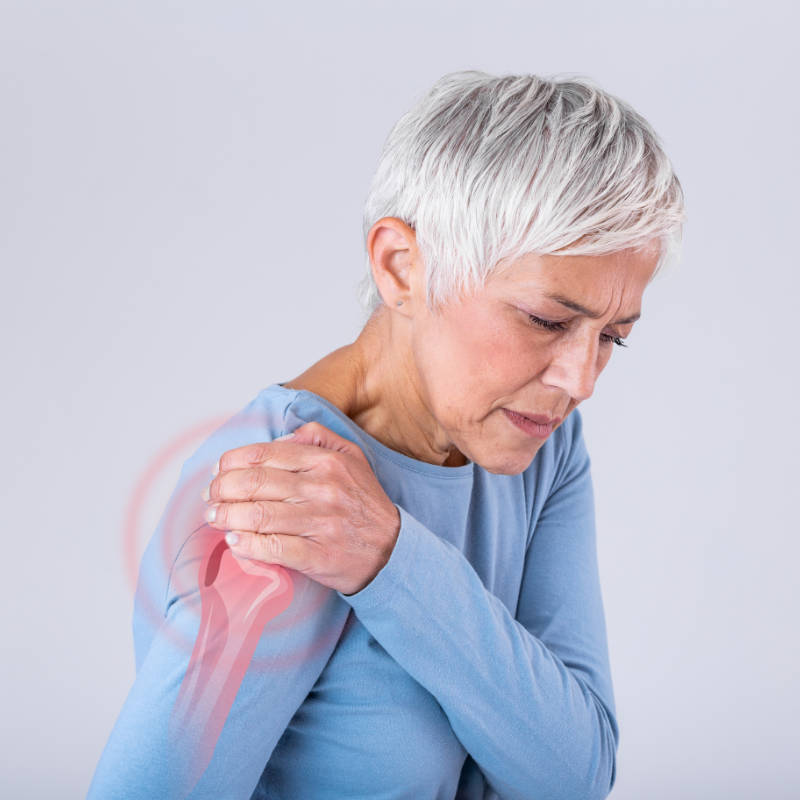
The shoulder joint is classified as a “ball-and-socket” type joint by medical professionals, comprising three key bones: the collarbone (clavicle), the shoulder blade (scapula), and the upper arm bone (humerus). These interconnected bones collectively allow the shoulder to possess the highest range of motion of any joint in the body. This is why shoulder injuries can significantly impact people’s lives.
Regenerative Medicine Therapy has been statistically proven to be more effective than many surgical procedures for treating shoulder injuries. A recent study revealed that nearly 60 percent of patients who underwent surgery for rotator cuff injuries did not achieve full recovery. Conversely, the same study demonstrated that over 72 percent of patients who received Regenerative Medicine Therapy for their rotator cuff injuries experienced substantial enhancements in functionality and range of motion, effectively leading to nearly complete recovery from their shoulder injuries. When regenerative tissues are reintroduced into the affected area, they enhance the natural repair process, combating bone degeneration, injured tendons, ligaments, and arthritic joints.
With Platelet-Rich Plasma (PRP) Therapy, we harness the healing potential of your own blood to address the injury causing you pain. By concentrating the platelets in the blood to levels beyond what the body can naturally produce, PRP injections promote natural healing in the afflicted area. We’ve witnessed noticeable symptom improvements in our patients within the initial weeks and months following therapy.
Shoulder injuries that can be helped by regenerative medicine therapy and platelet-rich plasma include:
AC Joint Pain
The AC joint is stabilized by ligaments that can be injured by a direct fall onto the front or top of the shoulder. This type of injury is called an AC joint sprain or separation.
Biceps Tear
A biceps tendon tear can happen at either the shoulder or the elbow. A tear can also be complete or partial.
Biceps Tendinitis
Biceps tendinitis implies degeneration and disorganization of the biceps tendon fibers, typically caused by overuse injuries. The long head of the biceps (one of the two biceps muscles) is most often the affected portion. There is a distal portion of the tendon, near the elbow joint, and a proximal portion of the tendon up by the shoulder. Both parts of the tendon can become tendinopathic or over-worked.
Brachial Plexus Injury
A brachial plexus injury happens when a network of nerves that send signals from your spinal cord to your shoulder, armor and are stretched, compressed or torn from the spinal cord.
Complex Regional Pain Syndrome (CRPS)
CRPS is an uncommon form of chronic pain that usually affects an arm or leg. Complex regional pain syndrome typically develops after an injury, surgery, or stroke.
Frozen Shoulder – Adhesive Capsulitis
Frozen shoulder, also called adhesive capsulitis, is a thickening and tightening of the soft tissue capsule that surrounds the glenohumeral joint, the ball and socket joint of the shoulder.
Rotator Cuff Syndrome
The rotator cuff tendons keep the humeral head in place while the arm goes through its various ranges of motion. Rotator cuff syndrome refers to any pathology that affects the rotator cuff tendons’ ability to function.
Rotator Cuff Tear
A rotator cuff tear is a tear in one of the rotator cuff tendons: the supraspinatus most commonly, but on occasion the infraspinatus, subscapularis, and teres minor.
Scapular Motion Dysfunction & Impingement
Scapular motion dysfunction or scapular dyskinesia refers to improper motion of the scapula, or shoulder blade, on raising and lowering the arm.
Shoulder Arthritis
Glenohumeral (shoulder) arthritis is one of the most common sources of pain and disability that affects up to 20% of the older population.
Shoulder Bursitis
A bursa is a potential space that sits between anatomic structures to allow for smooth gliding, and shoulder bursitis implies acute inflammation of the bursa.
Shoulder Labral Tear
Traumatic injury to the shoulder or overuse of the shoulder (throwing, weightlifting) may cause the labrum to tear. In addition, aging may weaken the labrum leading to injury.
Shoulder Pain
Shoulder pain, simply put, is pain around the shoulder region. This pain can be global or can be more localized to specific areas.
Shoulder Strain
A “strain” refers to a muscle injury while a “sprain” refers to ligament injury. Common true strains in the shoulder region include pec muscle strains.
Sternoclavicular Joint Pain
Sternoclavicular (SC) joint separation consists of ligament tearing to the joint connecting the breastbone [sternum] and the collarbone [clavicle].